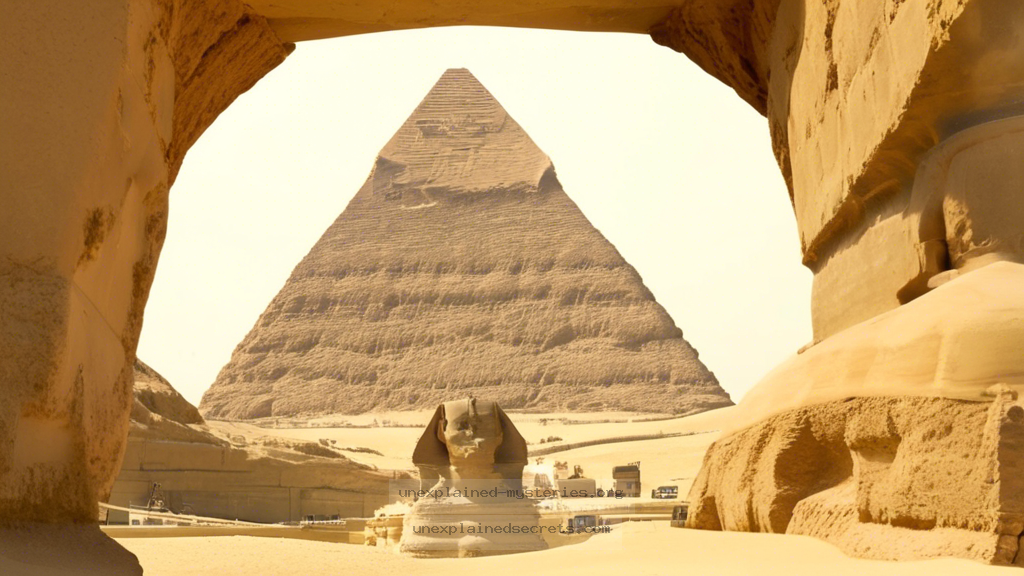What Secrets Lie Beneath the Great Sphinx of Giza?
What Secrets Lie Beneath the Great Sphinx of Giza?
The Great Sphinx of Giza stands as one of the most iconic symbols of Ancient Egypt, yet it is shrouded in mystery. This monumental statue, with the body of a lion and the head of a pharaoh, has captivated the imaginations of historians, archaeologists, and enthusiasts alike for centuries. But what secrets does this enigmatic structure hold beneath its weathered exterior? This question matters not only because of the Sphinx’s historical significance but also due to the potential insights it could provide into ancient civilizations and their lost knowledge. This blog post delves into the unexplained aspects of the Great Sphinx, exploring the historical context, core theories, and ongoing research surrounding this ancient wonder.
Historical Context: The Sphinx’s Origins
The Great Sphinx is estimated to have been constructed during the reign of Pharaoh Khafre (c. 2558–2532 BC), making it over 4,500 years old. It stands approximately 66 feet high and 240 feet long, carved from a single piece of limestone. The Sphinx is part of a larger complex that includes the Pyramid of Khafre and several other significant structures. Historically, it has been associated with solar worship, and its alignment suggests a connection to the sun god Ra.
Despite its grandeur, the Sphinx’s history is not well-documented. Ancient texts provide limited information, and much of what is known comes from later interpretations and hypotheses. The Sphinx’s face is often identified as that of Khafre, but some researchers argue it may also represent other figures due to erosion and restoration efforts over the millennia.
Theories Surrounding the Sphinx’s Purpose
The purpose of the Sphinx has been widely debated. Traditionally, it is viewed as a guardian of the Giza Plateau, but alternative theories suggest it served as a symbol of royal power or a representation of divine protection. Some scholars even propose that it may have had astronomical significance, aligned with celestial bodies during specific times of the year.
One particularly intriguing theory posits that the Sphinx may be a remnant of a lost civilization, predating the Egyptians. This idea aligns with theories of advanced ancient technologies that may have existed long before recorded history. Supporters of this theory often point to the precision of the Sphinx’s construction and its alignment with the stars as evidence of advanced knowledge.
Core Concepts: The Mystery of the Hidden Chambers
One of the most compelling mysteries surrounding the Sphinx is the possibility of hidden chambers beneath its body. In the early 1990s, a team of researchers utilized ground-penetrating radar (GPR) technology, revealing anomalies that suggest the presence of voids or chambers beneath the statue. These findings ignited speculation about what might be contained within these hidden spaces.
Some theories propose that these chambers could hold artifacts, ancient texts, or even a lost library of knowledge from a civilization that has long since disappeared. There is also speculation that these chambers may connect to other ancient structures in the Giza complex, creating a vast network of tunnels and passageways.
Practical Implications: Archaeological Investigations
The potential existence of hidden chambers beneath the Sphinx has prompted numerous archaeological investigations. In 2015, a team led by Dr. Zahi Hawass, a prominent Egyptian archaeologist, announced plans to explore these anomalies further. However, challenges such as funding, preservation concerns, and political issues have hindered extensive excavation efforts.
Recent studies have also aimed to assess the structural integrity of the Sphinx, as it has suffered considerable erosion and damage over the years. Preservation efforts are critical not only for the Sphinx itself but also for understanding the larger context of the Giza Plateau and its historical significance.
Alternative Perspectives: The Sphinx in Modern Culture
The Great Sphinx has transcended its historical roots to become a symbol in popular culture, often appearing in literature, film, and art. This cultural significance raises questions about how modern interpretations can influence our understanding of ancient mysteries. For example, fictional representations often imbue the Sphinx with mystical qualities, leading to a blend of reality and myth that can obscure historical facts.
Moreover, some conspiracy theories suggest that the Sphinx is part of a larger cover-up regarding ancient alien civilizations or advanced technologies that have been lost to time. While these theories often lack substantial evidence, they reflect the enduring fascination with the Sphinx and the mysteries it embodies.
Common Misconceptions: Erosion and Restoration
One common misconception regarding the Sphinx is that its face has remained unchanged since its construction. In reality, centuries of natural erosion, coupled with human intervention, have altered its features significantly. The Sphinx’s nose, for example, is famously absent, and various theories about its loss—ranging from vandalism to erosion—have circulated over the years.
Additionally, restoration efforts have sometimes obscured the original features of the statue. These interventions, while necessary for preservation, can lead to debates about authenticity and historical accuracy. Understanding these factors is crucial for anyone studying the Sphinx and its historical significance.
Best Practices for Investigating Ancient Mysteries
For researchers and enthusiasts alike, investigating ancient mysteries like the Sphinx requires a combination of rigorous methodology and creative thinking. Here are some best practices to consider:
- Utilize multidisciplinary approaches, combining archaeology, history, and technology.
- Document findings thoroughly to ensure transparency and accuracy.
- Engage with local communities and historians to gather diverse perspectives.
- Stay updated on the latest research and technologies that can aid in investigations.
- Be open to alternative theories while maintaining a critical perspective.
Future Developments: Ongoing Research and Exploration
The quest to uncover the secrets of the Great Sphinx is ongoing, with several exciting developments on the horizon. Recent advancements in non-invasive survey techniques, such as drones and 3D scanning, have opened new avenues for exploration. These tools allow researchers to gain insights into the Sphinx’s structure without causing damage.
Furthermore, international collaborations are becoming more common, bringing together experts from different fields to share knowledge and resources. As interest in ancient mysteries continues to grow, it is likely that more discoveries will emerge, potentially reshaping our understanding of the Sphinx and its role in ancient history.
Conclusion: The Enduring Mystery of the Sphinx
The Great Sphinx of Giza remains one of the most enigmatic and captivating symbols of ancient civilization. Its secrets—hidden chambers, potential connections to lost knowledge, and the true purpose of its construction—continue to elude definitive explanation. As research progresses and technology advances, we may one day uncover answers to the questions that have fascinated humanity for millennia.
In exploring the mysteries of the Sphinx, we not only seek to understand a single monument but also to gain insights into the civilizations that built it. The Great Sphinx stands as a testament to human ingenuity and the unending allure of ancient mysteries, reminding us that there is still much to learn from our past.
Other Articles
Recent Posts
- What Happened to Flight MH370? The Conspiracy Theories That Still Haunt Us
- What Secrets Lurk Within the Walls of the Infamous Trans-Allegheny Lunatic Asylum?
- What Evidence Supports the Existence of Bigfoot in the Pacific Northwest?
- What Happened to the Indus Valley Civilization? Unraveling the Mysteries of Ancient Urban Life
- Can Telepathy Be Scientifically Proven Through Laboratory Evidence?







